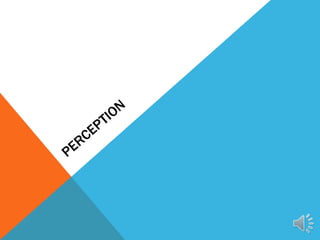246 4-recorded
- 2. PERCEPTION Made of three activities 1. Selecting 2. Organizing 3. Interpreting
- 3. BELIEFS âĒ Decision Made âĒ Statement on the Future âĒ Judgment of Quality âĒ Explaining the Meaning Interpretations Evaluations ConclusionsPredictions
- 4. TYPES OF BELIEFS Type Report of Fact Infer the Unknown Judge or Evaluation
Editor's Notes
- #2: When practicing the art of critical thinking, understanding perspective is an important component.Youâll see that not only is chapter 4 all about perceptionâĶ but that we use perception for the rest of the course as a element of analysis
- #3: When practicing the art of critical thinking, understanding perspective is an important component.Perception is created from three activities. Most people think of it just as one thing, âmy perspectiveâ or âmy point of viewâ, but by looking a the 3 parts, we can learn to understand our own perspectives and the perspective of others more effectively.The first part is selecting â This is the activity in which you choose what to focus on. You might think, âI focus on everythingâ or âI focus on the importantâ. But, that in and of itself is the problem. We think we select the right stuff, and we donât really know if we do. Consider the famous âInvisible Gorillaâ experiment, linked to the Quarter 2 folder. As youâll see on that website, participants in an experiment âselectedâ to count the number of passes by the basketball players in white t-shirts, and ignored, or did NOT select to focus on newly introduced informationâĶ in the form of a gorilla. We donât know what weâre missing until itâs pointed out to us.The second part is organizing. In this activity we put what weâve selected into a design or pattern. This sounds simple enough, like putting together a puzzle. And, in a sense, it is that simple. I think an important aspect to remember though, is that we all put the puzzle together a little differently. Look at the optical illusions on page 134 and 135 in the text. What did you see first? Did you see the ship at sea or the skull? Why did you see one, when I saw the other?Finally, we interpret. We take meaning away from the input we selected and the patterns we organized. We make judgments about what is right or wrong, we analyze what could be done differentlyâĶ and all of that thinking is part of the complicated process of developing perceptions.We tend to think our perceptions are ârightâ. That what we âseeâ is actually going on. The truth is, our perceptions are simply a story we tell ourselves by selecting, organizing and interpreting the world around us. And that story comes through a lenses. Your history, personality, values â all of it goes together to create your lenses through which you select, organize and interpret.
- #4: Interpretive - Macklemoreâs song Same love opens the conversation of homosexuality and marriage equality in the popular culture. Hereâs whyâĶ fill in with evidenceEvaluative â Macklemoreâs song Same Love is an excellent song because it is lyrically daring and musically beautifulConclusion â Macklemoreâs song Same Love helped me make up my mind about marriage equality; either for or against it.Predictions â After Macklemoreâs fresh focus on a critical topic, we will see many more public figures speak publicly on their opinion about marriage equality.
- #5: Reporting factual information is describing the world in ways that tan be verified. âI believe TCC has a Portsmouth campusâ can be verified. âI believe the average male elephant weighs 11,000 lbs.â Even if our cannot weigh the elephant yourself, you could verify this report through research and experimentionation.Inferring means going beyond the factual information into what is currently unknown. âI will graduate with honorsâ is an inference based on your previous experiences. Even if itâs likely it isn'tâ fact yet because it hasnât happened. Look carefully at page 161 to consider the slight difference between reports of fact and inferences of the yet unknown. Finally, beliefs can be judgments based on criteria. The criteria we utilize can come from the way were raised, the expectations in our homes or our workplaces, and from many other influences. The criteria is important though, because it is what we use as the ârulesâ to evaluate what is âgoodâ and what is âbadâ. If you think a song is good â why? It has a good beat or a catchy hook? Then, thatâs your criteria. The thing is, we donât all agree on the same criteria, and therefore we donât all come to the same beliefs. Do you blame the economic crash of 2008 on president bush, president obama, the federal reserve bank, greedy CEOs, disruption in overseas economies? Who you blame is your belief on the judgment of fault which ultimately relates back to your lense, perception, and your criteria.After reviewing this chapter, I hope you understand how important perception building and perspective taking is, and how perception is deeply entwined with our beliefs, which shape the way we see, predict and evaluate the world around us!




